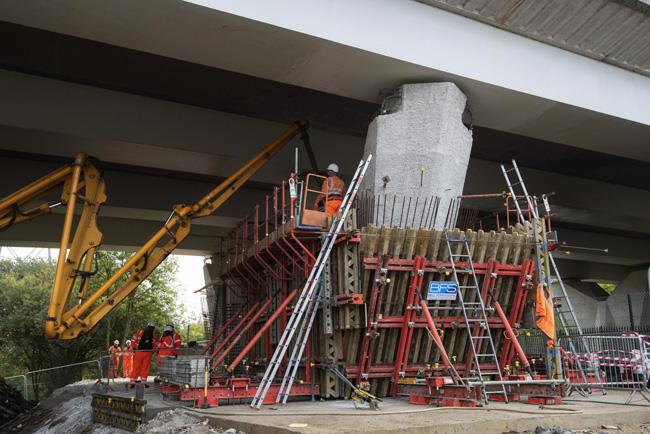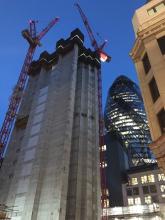
Constructed over the River Nene in the 1970s, Nene Bridge in Peterborough, UK is iconic for its ‘v’ shaped pier. It is a major traffic route and provides access to vehicles travelling from the A1 to A47, as well as pedestrians and cyclists going between the north and south of the city. The bridge is currently undergoing extensive renovations, including reinforcing the bridge piers and replacing bearings, as part of a repair programme being carried out by Skanska.
Recent inspections of the bridge revealed signs of structural distress to the bearings and cracking to the saddles of the piers. Traditional methods of replacing the bearings were not possible because the ornate architectural design of the original piers did not allow space on top of the piers for jacks to be positioned beneath the superstructure replacing the bearings. In addition, jacking points were not provided within the box girders.
The designers at Skanska therefore considered various options for replacing the bearings and strengthening the piers, whilst remaining sympathetic to the appearance of the original piers.
This led them to develop the solution of encasing the piers in reinforced concrete jackets, to strengthen the piers and also to provide jacking platforms for the superstructure lifted to enable the bearings to be replaced. For this solution to work, the concrete used in the jackets needed to be strong enough to strengthen the piers and to carry the jacking loads, self-compacting, to flow around the dense reinforcement, and lightweight, to minimise the additional load on the foundations.
Aggregate Industries suggested the use of Lytacrete, a concrete mix using the lightweight secondary aggregate Lytag, which the company says can effectively reduce the dead load by approximately 25% over normal weight control while offering the same level of structural performance. Aggregate Industries will be supplying its solution to the ongoing project over the next 12 months.
Throughout the project, Lytacrete has been placed around the piers, and owing to its high strength and self-compacting nature, this meant the mixture needed to be free flowing to ensure it could be placed around the complex and congested steel reinforcement. As a result, Aggregate Industries says the solution has proved ideal for strengthening the pier as well as maintaining its ‘v’ shaped design.
Dan Wood, site manager for Skanska Infrastructure Services, said: “Lytacrete has performed well on the Nene Bridge bearings project, successfully flowing around the complex steel reinforcement to form the unique geometry required.”







